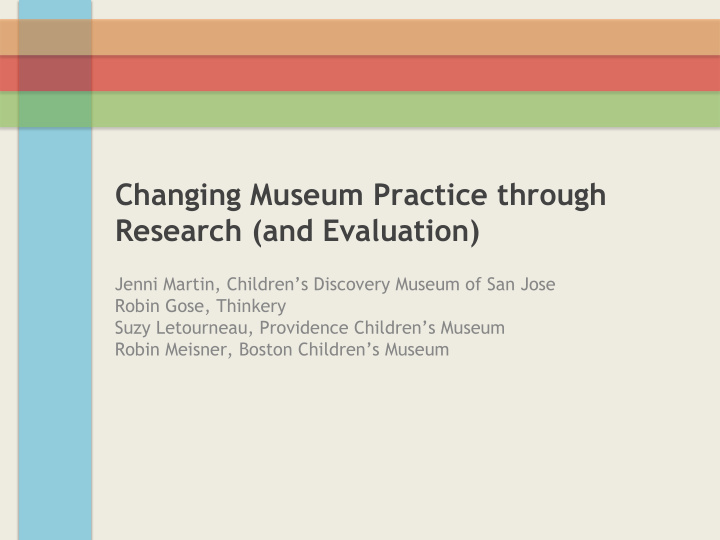



Changing Museum Practice through Research (and Evaluation) Jenni Martin, Children’s Discovery Museum of San Jose Robin Gose, Thinkery Suzy Letourneau, Providence Children’s Museum Robin Meisner, Boston Children’s Museum
Plan for the Workshop ⬝ About us ⬝ Description of the research process ⬝ Case studies in 3 museums ⬝ Reflection & Discussion
About Us Connected initially through Lupe’s Story - an exhibit ⬝ development/research project at Children’s Discovery Museum of San Jose Currently working together on Explaining and Exploring - a ⬝ collaborative research project with three university partners Each museum brings a range of experiences in doing ⬝ research and evaluation both as individual institutions and with outside collaborators
Providence Children’s Museum Mission: To inspire and celebrate learning ⬝ through active play and exploration About the Museum Serving children ages 1-11 and their ⬝ adult caregivers Audience: Approx. 160,000 visitors each year ⬝ ⬝ Most (90%) visit in family groups 30% welcomed free of charge ⬝ 25% of visits by ~2000 member families ⬝ Children’s ages: 1-2 (31%), 3-4 (30%), ⬝ 5-8 (30%), 9+ (7%); Average age = 4 Approx. 17,000 sq. ft. ⬝
Thinkery Mission: To create innovative learning ● experiences that equip and inspire About the Museum the next generation of creative problem solvers Existed as Austin Children’s Museum ● since 1983; reimagined and rebranded in 2013 Audience: ● Approx. 450,000 visitors each year 45% of our visitors are < 8 years old ● ● 60% of annual visitors are members Approx. 40,000 sq. ft. (17K exhibit ● space)
Children’s Discovery Museum of San Jose Mission: To inspire creativity, curiosity, and lifelong ⬝ About the Museum learning so that today’s children become tomorrow’s visionaries. Audience: 400,000+ visitors per year comprised of ⬝ families and school field trips 60% come from within a 10-mile radius; ⬝ additional 25% from up to 30 miles Open Door Policy and Museums for All ⬝ program serve 60,000 annually Audience demographics mirror San Jose ⬝ demographics
Research Process 1. Gathering information, defining questions 2. Choosing methods, building capacity 3. Interpreting findings, making decisions
Gathering Information, Defining Questions
Providence Children’s Museum Using research, theory, and evaluation to inform practice ● Educational philosophy defined in 1978, updated in 1997 ○ ○ Play advocacy began in 2008 with opening of Play Power Detailed Learning Frameworks created in 2014 ○ History Ongoing evaluation of exhibits ○ Partnering with university researchers ● Began working with Brown University in 2003 ○ ○ Formalized Mind Lab partnership in 2010 Collaborative grant-funded projects began in 2012, 2015 ○
Providence Children’s Museum Defining Questions Research Partner’s Museum’s Interests Interests Learning through Play Cognitive Development and Exploration Causal Reasoning Play Advocacy Understanding Learning (in Inspiring & Supporting general) Learning (in context) Shared Research Interests Metacognition: Reflecting on Learning Making Learning through Play Visible (during museum visits)
Providence Children’s Museum Learning About Learning Project Funded by NSF (Award #1223777) in collaboration with Brown University Defining Questions Research Questions: ⬝ How do children reflect on their own thinking and learning? ⬝ How is children’s thinking visible in their play at the Museum? What do caregivers notice and value about their children’s play? ⬝
Providence Children’s Museum Methods used: Observations, interviews with caregivers, discussions with educators, iterative prototyping Methods and Findings Decisions made: Final exhibit tools connect play and learning through concrete, observable examples
Reflection Questions: ⬝ What are priority topics for your institution? ⬝ What questions are important to you? ⬝ What questions or topics are your research partners interested in? How do they align with your own?
Choosing Methods, Building Capacity
Thinkery ● Historically, evaluation focused on particular programs and was driven by reporting requirements to funders. Research was driven by external research scientists. Choosing Methods ● As the organization matures there is a move to systematically measure and communicate the impact of the museum overall. INTERNAL EXTERNAL Visitor Experience ● ● University of Texas ○ Surveys, focus Cognitive Psychology ○ groups, social media ● Exhibits and Programs Prototypes, surveys, ○ observation protocols
Building Capacity Thinkery
Thinkery ● Building a work culture that mirrors design Building Capacity process ● Working closely and collaboratively with University partners ● Know when you need help! ○
Discussion Questions: ⬝ What do you need to be able to answer your question? ⬝ What capacity do you already have (either internally or with external partners)? ⬝ What capacity could be built?
Interpreting Findings, Making Decisions
Children’s Discovery Museum of San Jose Jipson et al., 1996; Crowley et al.; 2001 Interpreting Findings Do Parents explain differently to boys versus girls in the museum? Parents gave many more explanations to boys than to girls.
Children’s Discovery Museum of San Jose Can we reduce the gender gap? Interpreting Findings Alice’s Wonderland exhibition with exhibit theme seen as relevant to girls. (Callanan, Esterly, Martin, Frazier, & Gorchoff, 2002)
Children’s Discovery Museum of San Jose Sample finding 2: In “Alice” exhibit, no gender difference in explanations! Making Decisions
Children’s Discovery Museum of San Jose What if research and exhibit design intentions are at odds Making Decisions with each other?
Discussion Questions: ⬝ What could be important about the findings for your museum, or for the field as a whole? ⬝ How might the findings affect the visitor experience? ⬝ Are you willing/ready to make changes based on the findings? ⬝ Can you imagine a situation when you might not make changes? ⬝ What other practical considerations factor into this decision?
Recommend
More recommend